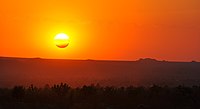
Photo from wikipedia
Abstract It is well known that addition of some nanoparticles (NPs) to a base fluid can enhance solar radiation absorption; however, its influence on simultaneous solar energy harvesting and daylighting… Click to show full abstract
Abstract It is well known that addition of some nanoparticles (NPs) to a base fluid can enhance solar radiation absorption; however, its influence on simultaneous solar energy harvesting and daylighting is seldom studied. Water is nearly transparent to visible (VIS) light but highly absorbing of ultraviolet (UV) and infrared (IR). It is necessary to examine the performance of water-based nanofluid in a glass louver for dual purpose – illumination and energy harvesting. First, we investigated the absorption and scattering efficiencies of NPs commonly used in solar energy research including Ni, SiO2, Fe2O3, Al2O3, TiO2 and ZnO; and found that Ni NPs are the most desirable because they have an excellent balance between UV and IR absorption and VIS transmission. Then the spectral coefficients of absorption and scaled isotropic scattering with different NP sizes and concentrations in Ni-water nanofluids were scrutinized. Results show that the higher the NP size or concentration is, the higher are the absorption and scaled isotropic scattering coefficients. A dilute 0.00004 vol% Ni-water nanofluid with particle diameter of 80 nm was found to absorb more solar energy and provide required daylighting. Under AM1.5 model, a glass louver filled with such a nanofluid can transmit 46.5% solar VIS for daylighting and harvest 65.7% of the total solar energy, which is a 25.9% increase as compared to pure water.
Journal Title: International Journal of Heat and Mass Transfer
Year Published: 2020
Link to full text (if available)
Share on Social Media: Sign Up to like & get
recommendations!